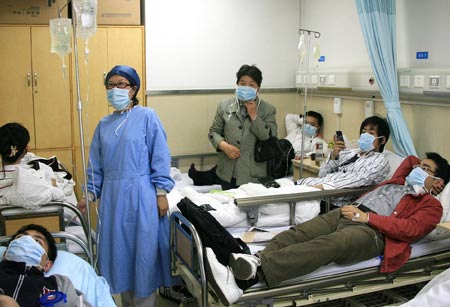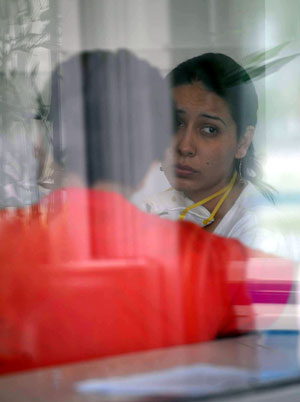Quarantined Passengers Show No Flu Symptoms
Adjust font size:
 |
|
Some patients are seen at the fever diagnosis ward of Shanghai East Hospital in Shanghai, east China, on May 3, 2009. Shanghai East Hospital opened fever diagnosis ward and express way for the fever patients for preventing influenza A/H1N1. [Xinhua]
|
All the passengers aboard Thursday's Mexican flight Aeromexico 098 from Mexico City to Shanghai have been located and those who remained in China were quarantined, the ministry said.
The Mexican, a 25-year-old male, arrived in Shanghai Thursday aboard the flight, which carried 176 passengers and 13 crew. Hourslater, he and some other passengers left for Hong Kong on China Eastern Airlines flight MU505.
He was confirmed on Friday in Hong Kong to be infected with influenza A/H1N1. It was also the first such case in Asia.
Mao Qun'an, an official with the ministry, said China had "redoubled its prevention and control efforts" following the notification from Hong Kong, including tracing the passengers and putting them under medical observation, suspending flights from Mexico starting Saturday, and stepping up communication with Hong Kong and the World Health Organization.
Strict quarantine
The week-long quarantine in Shanghai affects 68 people, including 48 passengers whose destination was Shanghai, seven who intended to go on to other destinations, and 13 crew members.
They were divided into two groups in two hotels, one in Nanhui district, the other in Pudong district.
Fifty-nine relatives of the 48 Shanghai passengers were asked to stay at home for observation.
Another 28 people who had close contacts with the Mexican at the airport were also under observation at home. They include two customs staff, eight border police, six China Eastern staff and 12safety inspectors.
Among the 176 passengers on AM098, excluding the 55 in Shanghai,111 went to 18 Chinese provinces and municipalities, which have taken similar measures against the epidemic, while 10 others left the Chinese mainland, going to Japan, Thailand and Hong Kong.
Learning from SARS in 2003
Fifteen passengers aboard the Mexican flight were admitted to Beijing Ditan Hospital, including five Mexican nationals.
"After admitting these 15 passengers, our professionals took samples to check for the presence of A/H1N1. All of their temperatures were normal and none showed any flu symptoms. According to the requirement of the government, we will observe them for another seven days." said Chen Jun, deputy head of Beijing Ditan Hospital.
Beijing Ditan Hospital was designated as the primary hospital for flu cases by the Beijing Health Bureau on April 28. The hospital has made contingency plans by training doctors, preparing medicines and stocking up on protective clothes and masks.
"Learning from the 2003 SARS outbreak, Beijing Ditan Hospital is ready to deal with any infection. We have confidence that we can control A/H1N1 and protect Beijing and our country," Chen said.
The hospital has an emergency working group, with another on standby. If there is a serious outbreak, the hospital will bring in 22 doctors from overseas to help, Chen said.
Pig import suspension
In another virus prevention efforts, China on Sunday announced moves to suspend imports of pigs or relevant products from Alberta of Canada.
The General Administration of Quality Supervision, Inspection and Quarantine and the Ministry of Agriculture made the decision after some pigs in the province of Alberta had been found to be infected with the A/H1N1 flu Saturday.
The pigs or relevant products sent to China after the declaration would be destroyed and those sent to China before Saturday would have to pass A/H1N1 tests, the announcement said.
Passengers are not allowed to take pigs or relevant products into China and no pigs or relevant products would be allowed to be mailed to the country, the announcement said.
Transport vehicles from the affected areas would be quarantined, the announcement said.
Enhanced surveillance, communication
While strengthening body temperature monitoring and health condition registration at customs and airports, the country has also beefed up surveillance at medical facilities and would immediately report and treat suspected cases, he said in an interview with Xinhua on Sunday.
Due to the high risk of a pandemic caused by the A/H1N1 virus, the WHO has raised the alert level to Phase 5 and said there was still the possibility to adjust it to the highest level -- Phase 6.
Mao promised China would enhance communication with the WHO and relevant countries, closely follow the latest development of the epidemic and its control work, and take effective measures to ensure public health security in the country.
China has developed its own method of making quick tests for the A/H1N1 virus by analyzing nucleic acid, which takes just 12 hours.
The China CDC is training staff from epidemic monitoring stations across the country to do the nucleic acid test, and the reagent will be distributed to all 84 stations, said Mao.
The China CDC obtained the sequence of the A/H1N1 virus from the US Centers for Disease Control on April 27 and the primer for making nucleic acid tests from WHO on April 28.
Chartered flight to Mexico cancelled
The government has promised to send a chartered flight to pick up 120 or so stranded Chinese citizens in Mexico, but the flight operator China Southern Airlines (CSA) said Sunday night that it was cancelled.
"Normal flight CZ327 has left for Los Angeles Sunday night, but it would not fly to lift the Chinese nationals in Mexico as earlier planned," the center of the influenza A/H1N1 outbreak, the CSA said.
The Guangzhou-based airline added that it was fully prepared for the charter mission, but it was up to the government as to if and when to implement it.
 |
|
Two people wait for being examined in Beijing Ditan Hospital in Beijing, capital of China, on May 2, 2009. Beijing Ditan Hospital has been designated to treat influenza A/H1N1 by Beijing Health Bureau since April 28. [Xinhua]
|